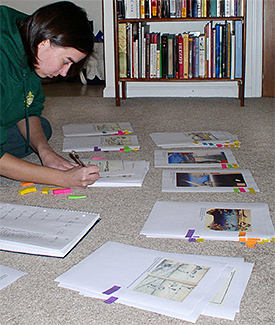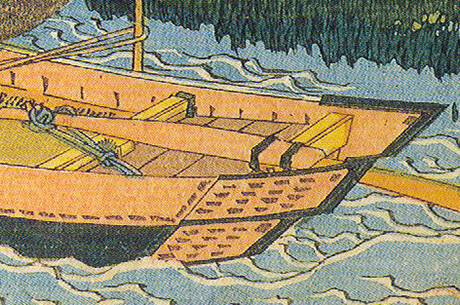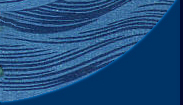
More Organization, More Questions
14 February 2007
By Michelle Damian
Once again I need to begin by thanking all those who commented after the last journal entry. Many people sent in helpful suggestions about categorizing and ensuring the ability to cross-reference things. All of the ideas have been great help in creating my own system, which I’m sure will continue to be modified as I progress.

Michelle takes notes on the printed copies of the woodblock prints.
At the moment I have a hybrid categorization system going, with an Excel spreadsheet detailing the painting specifics (artist name, painting title, description and historical background, as well as any construction details that exist), and the low-tech solution of colored sticky notes. I’m a visual person and after scanning in close to 250 prints, I needed some way to see more clearly what I was dealing with. While the spreadsheet lets me have any number of fields to type details in, I still needed a way to cope at-a-glance with the prints themselves. Enter the color coding.
It’s simplistic perhaps and will be refined, but for now I have been looking mostly at a) scene location, b) type of vessel, and c) construction details. Each parameter has been designated a sticky note (bright pink is for cargo vessels, green is fishing, and so on) with additional notations on the stickies to narrow things down further. So a copy with an orange sticky bearing the notations “Y, B, I” means that it’s a passenger vessel (orange sticky) with a deck house (Y for “yanebune” or “yakatabune,” pleasure boats), with good construction details on the bow (B) and interior (I). This will probably end up incorporated into the Excel spreadsheet and converted to an Access database soon to allow for quick manipulation, but for now it’s helped me wrap my head more around what I’m looking at.
And there are questions indeed, that I hope will soon be resolved when I’m actually in Japan. Certain things just don’t come across in the prints. One mystery is the horizontal dashes that are visible in many of the vessels. By looking at the prints they appear to be some kind of fastener, almost the lashings of a lap-strake vessel. In some of the photos of reproductions or construction treatises that I’ve seen so far, however, it almost looks like those are just notches in the wood. Why are they there? And why are there so many in some of the sterns? It should be a simple question to answer, but one that’s mysterious when just looking at the prints alone. And if they are just notches, the reason behind it may not be so easy to fathom. Aesthetic? Why did such a tradition develop? I’m looking forward to asking those questions when I’m in Japan.

Detail fromTone River in Shimosa Province, Katsushika Hokusai. Note the markings on the stern.
That has been the other major production these past two weeks: a flurry of emails back and forth to a number of organizations and people in Japan. I’ve been overwhelmed at the response, particularly from members of the Asian Research Institute of Underwater Archaeology, who are very kindly arranging visits for me to several museums and to observe a traditional shipwright in Fukuoka. It will be a whirlwind trip but a fascinating one, taking me from the Tokyo area to Fukuoka and a number of cities in between. And oh how I am looking forward to some good sushi while I’m there!
So I will keep categorizing and organizing, try to make some determinations about construction styles and vessel uses, and prepare a long list of questions for the shipwrights and museums in Japan!
As always please feel free to contact me at muaprojectjournal@yahoo.com with any comments, questions, or suggestions during the weeks to come. Yoroshiku onegai shimasu ("I look forward to your good favor").
Return to Project Journal home page.

